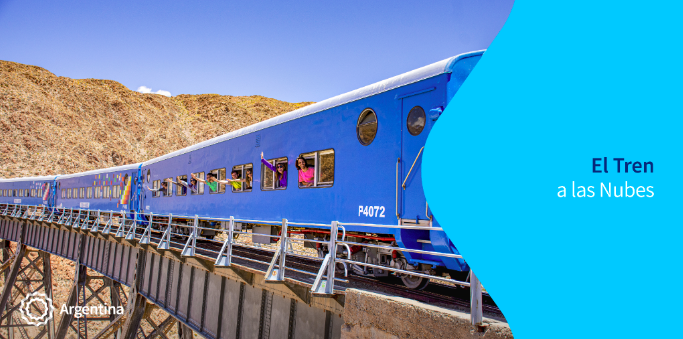
El Tren a las Nubes
El Tren a las Nubes nace en el año 1972 como emprendimiento ferroturístico. Reconocido por transitar a través de paisajes únicos y exclusivos en el mundo, está ubicado estratégicamente en la provincia de Salta. Los miles de periodistas, comunicadores y turistas nacionales e internacionales que viajaron en él, lo describen como una experiencia inolvidable, ya que durante su recorrido pueden apreciarse las obras más imponentes de la ingeniería del siglo pasado, además de las regiones más pintorescas y rústicas con sus distinguidas artesanías, sus museos y su gastronomía autóctona.
El Tren a las Nubes sale de la ciudad de Salta, a unos 1187 m.s.n.m., y llega hasta el Viaducto La Polvorilla, a unos 4.220 m.s.n.m., y a lo largo de su trayecto, que dura aproximadamente una hora, pasa por Campo Quijano, El Alfarcito, Santa Rosa de Tastil y San Antonio de los Cobres, entre otros lugares que ofrecen una naturaleza impactante. Según cuenta la leyenda entre los pobladores de la zona, es el intermediario directo entre la tierra y los sueños, y el responsable de que la Puna Salteña se fusione con el cielo.
Los viajes incluyen sorpresas inesperadas, casamientos y salidas temáticas, que conectan a los pasajeros con las emociones, la aventura, el paisaje, la geología, los pueblos originarios, el asombro, la ecología y todas las maravillas, tanto las naturales como las que fueron creadas por el hombre en la Puna Salteña.
El Mercado Artesanal de San Antonio de los Cobres, el Paseo Anatolio y sus llamas, la Iglesia San Antonio de Padua, el Paseo "Thuru Mmaki" (Manos de Barro) y el Museo Regional Andino de San Antonio de los Cobres, son algunos de los atractivos culturales más importantes que ofrece.
A su vez, viajar en el Tren a las Nubes permite descubrir pueblos históricos como Payogasta, que tiene dos siglos de historia y conserva, parcialmente, la imagen urbana y las características singulares que tenía en sus orígenes.
Los miles de turistas nacionales y extranjeros que viajan anualmente en el Tren a las Nubes, para conocer los paisajes más atractivos de la provincia de Salta, generan un impacto favorable en las economías regionales de esta provincia. Por eso, no sólo es un ícono turístico, sino también, un factor fundamental para el desarrollo productivo de las comunidades que atraviesa, además de una propuesta turística que destaca los valores positivos y propios de la Argentina.
El recorrido, que combina tramos terrestres con otros viales, cuenta con baterías sanitarias ubicadas en las diferentes localidades que están incluidas en la ruta. También, con asistencia médica a bordo, cobertura médica en caso de imprevistos para cada pasajero, un plan de contingencias, seguimiento de camionetas 4x4 y anfitriones que guían a los pasajeros durante el viaje.
La Marca País busca posicionar a la Argentina en el contexto internacional, difundiendo y promocionando íconos turísticos como el Tren a las Nubes. Se trata de una herramienta útil para reafirmar la identidad nacional mediante aquellos factores que nos distinguen del resto del mundo.
The Tren a las Nubes (English: Train to the Clouds) was born in 1972 as a railway-tourism enterprise. Renowned for passing through unique and exclusive landscapes in the world, it is strategically located in the province of Salta. Thousands of journalists, communicators, and national and international tourists who have traveled on it, describe it as an unforgettable experience since, during the journey, one can appreciate the most impressive engineering works of the last century, as well as the most picturesque and rustic regions with their distinguished handicrafts, museums, and local cuisine.
The Train to the Clouds departs from the city of Salta, at 1187 m.a.s.l., and reaches the La Polvorilla viaduct, at 4220 m.a.s.l., the highest of the line. Along its journey, which lasts approximately one hour, it passes through Campo Quijano, El Alfarcito, Santa Rosa de Tastil and San Antonio de los Cobres, among other places that offer stunning natural landscapes. According to legend among the inhabitants of the area, it is the direct intermediary between the earth and the realm of dreams, and is responsible for the Puna Salta merging with the sky.
Trips often include fantastic surprises, weddings, and thematic outings, which connect passengers with emotions, adventure, landscapes, geology, native peoples, amazement, ecology, and all the wonders—both natural and man-made—of the Puna Salta.
The Handicraft Market of San Antonio de los Cobres, the Anatolio Promenade and its llamas, the San Antonio de Padua Church, the "Thuru Mmaki" (Hands of Clay) Promenade and the Andean Regional Museum of San Antonio de los Cobres are some of the most important cultural attractions it has to offer.
On the other hand, traveling on the Train to the Clouds allows one to discover historic towns such as Payogasta, which boasts two centuries of history and partially preserves the urban image and unique characteristics that it had in its origins.
The thousands of domestic and foreign tourists who travel annually on the Train to the Clouds to see the most astonishing landscapes of the province of Salta generate a favorable impact on the regional economies of this province. Therefore, it is not only an iconic tourist attraction, but also a fundamental factor for the productive development of the communities it passes through, as well as a tourist enterprise that highlights the positive and characteristic values of Argentina.
The route, which winds through tunnels, viaducts and bridges, includes sanitary facilities located in the different towns it traverses. The train itself, which is followed by 4x4 trucks, has on-board medical assistance, medical coverage for each passenger in case of unforeseen events, a contingency plan, and hosts who guide passengers during the trip.
Marca País seeks to position Argentina on the international stage, disseminating and promoting iconic tourist attractions such as the Train to the Clouds. It is a useful tool to reaffirm our national identity through those factors that distinguish us from the rest of the world.